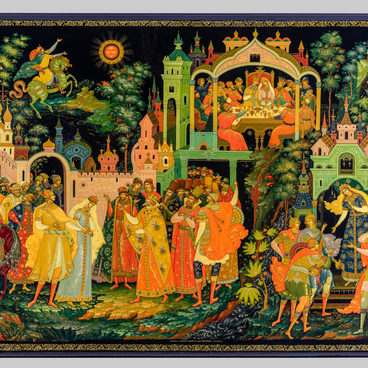Nikolai Lopatin created ‘The Tale of Tsar Saltan’ lacquer miniature in 1999. He was a prominent artist on the Palekh art scene in the early 2000's.
He created many artworks based on Alexander Pushkin’s fairytales. He dedicated a large portion of his work to specific images and episodes from these poems. Nikolai Lopatin did not just illustrate them: he aimed to depict the event on the divine scale, like the older generations of Palekh masters.
Researchers compare the image in “The Tale of Tsar Saltan” with the solemn, “hymn-like” air of the 15th century Old Russian “Rejoices in You” icon.
The icon painters have arranged their piece around the figure of Mother of God, and Nikolai Lopatin arranged his work around the Swan Princess. The artist even placed her figure in a golden oval of “glory” (“glory” is a special divine light; the radiance announcing the presence of the messenger of God in all his power).
The ties to the iconographic tradition are further strengthened by the portrayals of heavenly gardens and the shining city on a hill. The fantastical flowers beyond the white walls are symbolizing the Hortus Conclusus (the enclosed garden; in the bible, it is mentioned thus: “You are a garden locked up, my sister, my bride; you are a spring enclosed, a sealed fountain; Your plants are an orchard of pomegranates with choice fruits, with henna and nard, nard and saffron, calamus and cinnamon, with every kind of incense tree, with myrrh and aloes and all the finest spices”). The wondrous city from the fairytale in Lopatin’s artwork is reminiscent of the divine image of Jerusalem.
The artist has arranged the composition of his miniature in levels, showing the connection between the earthly world and the perfect heavenly world. This contrast is further highlighted by the colour palette. The artist contrasted warm and cold hues to make individual levels pop.
The lower part is dominated by warm earth tones and rich reds. Above are the subtlest white tones so beloved by the artist. The artist also made the most of the casket’s black base color: the background ties the composition together and provides a start contrast for the bright colors.
He created many artworks based on Alexander Pushkin’s fairytales. He dedicated a large portion of his work to specific images and episodes from these poems. Nikolai Lopatin did not just illustrate them: he aimed to depict the event on the divine scale, like the older generations of Palekh masters.
Researchers compare the image in “The Tale of Tsar Saltan” with the solemn, “hymn-like” air of the 15th century Old Russian “Rejoices in You” icon.
The icon painters have arranged their piece around the figure of Mother of God, and Nikolai Lopatin arranged his work around the Swan Princess. The artist even placed her figure in a golden oval of “glory” (“glory” is a special divine light; the radiance announcing the presence of the messenger of God in all his power).
The ties to the iconographic tradition are further strengthened by the portrayals of heavenly gardens and the shining city on a hill. The fantastical flowers beyond the white walls are symbolizing the Hortus Conclusus (the enclosed garden; in the bible, it is mentioned thus: “You are a garden locked up, my sister, my bride; you are a spring enclosed, a sealed fountain; Your plants are an orchard of pomegranates with choice fruits, with henna and nard, nard and saffron, calamus and cinnamon, with every kind of incense tree, with myrrh and aloes and all the finest spices”). The wondrous city from the fairytale in Lopatin’s artwork is reminiscent of the divine image of Jerusalem.
The artist has arranged the composition of his miniature in levels, showing the connection between the earthly world and the perfect heavenly world. This contrast is further highlighted by the colour palette. The artist contrasted warm and cold hues to make individual levels pop.
The lower part is dominated by warm earth tones and rich reds. Above are the subtlest white tones so beloved by the artist. The artist also made the most of the casket’s black base color: the background ties the composition together and provides a start contrast for the bright colors.



